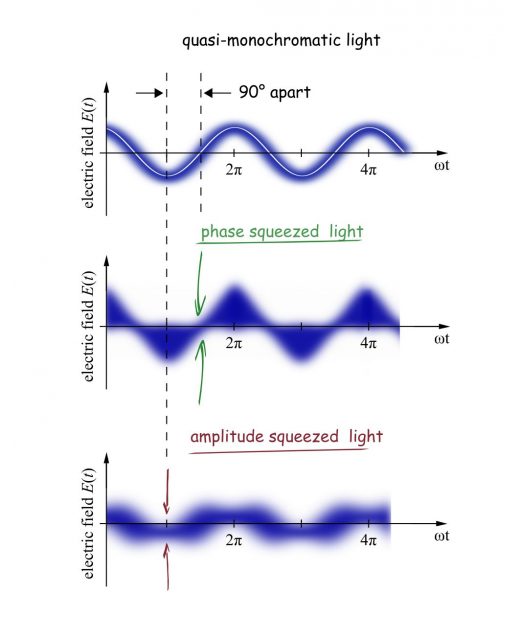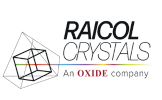
- July 3, 2022
- Yoad Michael
- 0
In spontaneous parametric down-conversion (SPDC), a pump beam is converted into pairs of correlated photons known as the signal and idler. These correlations can manifest in various ways, one of which is squeezed light, where the quantum uncertainty of one quadrature of the electric field is reduced (“squeezed”), while simultaneously increasing the uncertainty in the other quadrature (“anti-squeezed” or “stretched”). A simple illustration is given in Fig. 1, comparing a classical field (which has equal uncertainty in both quadratures) with phase-squeezed and amplitude-squeezed light.

Figure 1: Illustration of squeezed light. Shared with permission from Dr. Axel Schönbeck.
Squeezed light has various applications, with a popular example being the improvement of the sensitivity of measurement (or signal-to-noise ratio) in quantum sensing. The degree of squeezing quantifies by how much the noise of the squeezed quadrature is reduced below the shot-noise of the classical field, and is typically represented in decibel scale.
Raicol’s ppKTP was (and still is) a prominent source for the generation of squeezed light in many groundbreaking experiments. One popular source, built by the group of Prof. Roman Schnabel, was integrated into the GEO600 detector [1], recently improving the phase sensitivity of the interferometer by up to 6dB. To the best of our knowledge, this group currently holds the world record in the generation and measurement of squeezing, with numbers like 13 dB [2] being casually discussed (!!!).
While the detection of gravitational waves is an interesting application, squeezed light can also benefit “down-to-earth” technologies. Recently, the group of Prof. Warwick Bowen utilized squeezed light in the context of Raman spectroscopy [3], allowing the detection of molecular samples at low light powers. Here the sub-shot-noise scaling proved crucial, as the less-sensitive classical light requires higher optical powers that induce photo-damage in the sample.
Other than quantum sensing, squeezed light also appears in the quantum computing race, being a key resource for Gaussian Boson sampling (for more detail, see our previous post which discusses USTC’s famous work). Two recent works that also utilized ppKTP as a source for quantum light were carried out by Xanadu [4] and QuiX [5].
It is worth pointing out that there are many alternative sources for generating squeezed light – while they generally do not reach the same degree of squeezing by bulk crystals in an OPO, they are often more accessible. For example, the group of Prof. Akira Furusawa has shown 6dB squeezing with a ppLN waveguide [6]. The development of a ppKTP waveguide is one of our future goals at Raicol, although it is important to remember that in squeezed light there are other considerations other than the strength of the nonlinear response [7, 8].
Raicol is currently collaborating with Prof. Avi Pe’er on the development of monolithic ppKTP crystals, which are aimed as both sources of squeezed light and detectors through the parametric homodyne method [9]. We are also part of the QuantERA SPARQL consortium, which aims to utilize squeezed light through sequential parametric amplification for various applications.
To conclude, squeezed light is a promising resource for many quantum technologies. We are happy to see our crystals enabling these applications, and we’re constantly looking for ways to better adapt our products to fit their required applications. For more information on our products, feel free to contact us.
Bibliography
[1] J. Lough et al. “First Demonstration of 6 dB Quantum Noise Reduction in a Kilometer Scale Gravitational Wave Observatory”, Phys. Rev. Lett. 126, 041102 (2021).
[2] A. Schönbeck et al. “13 dB squeezed vacuum states at 1550 nm from 12 mW external pump power at 775 nm”, Optics Letters 43, 1, 110-113 (2018).
[3] C.A. Casacio et al. “Quantum-enhanced nonlinear microscopy”, Nature 594, 201–206 (2021).
[4] L.S. Madsen et al. “Quantum computational advantage with a programmable photonic processor”, Nature 606, 75–81 (2022).
[5] C. Taballione et al. “20-Mode Universal Quantum Photonic Processor”, arXiv:2203.01801 (2022).
[6] T. Kashiwazaki et al. “Continuous-wave 6-dB-squeezed light with 2.5-THz-bandwidth from single-mode PPLN waveguide”, APL Photonics 5, 036104 (2020).
[7] M. Stefszky et al. “An investigation of doubly-resonant optical parametric oscillators and nonlinear crystals for squeezing”, J. Phys. B 44 015502 (2011).
[8] Z. Wan et al. “Comparison of phase quadrature squeezed states generated from degenerate optical parametric amplifiers using PPKTP and PPLN”, Optics Express 26, 5, 5531-5540 (2018).
[9] Y. Shaked et al. “Lifting the bandwidth limit of optical homodyne measurement with broadband parametric amplification”, Nature Communications 9, 609 (2018).
Raicol
Rosh Ha’Ayin 4809162, Israel
